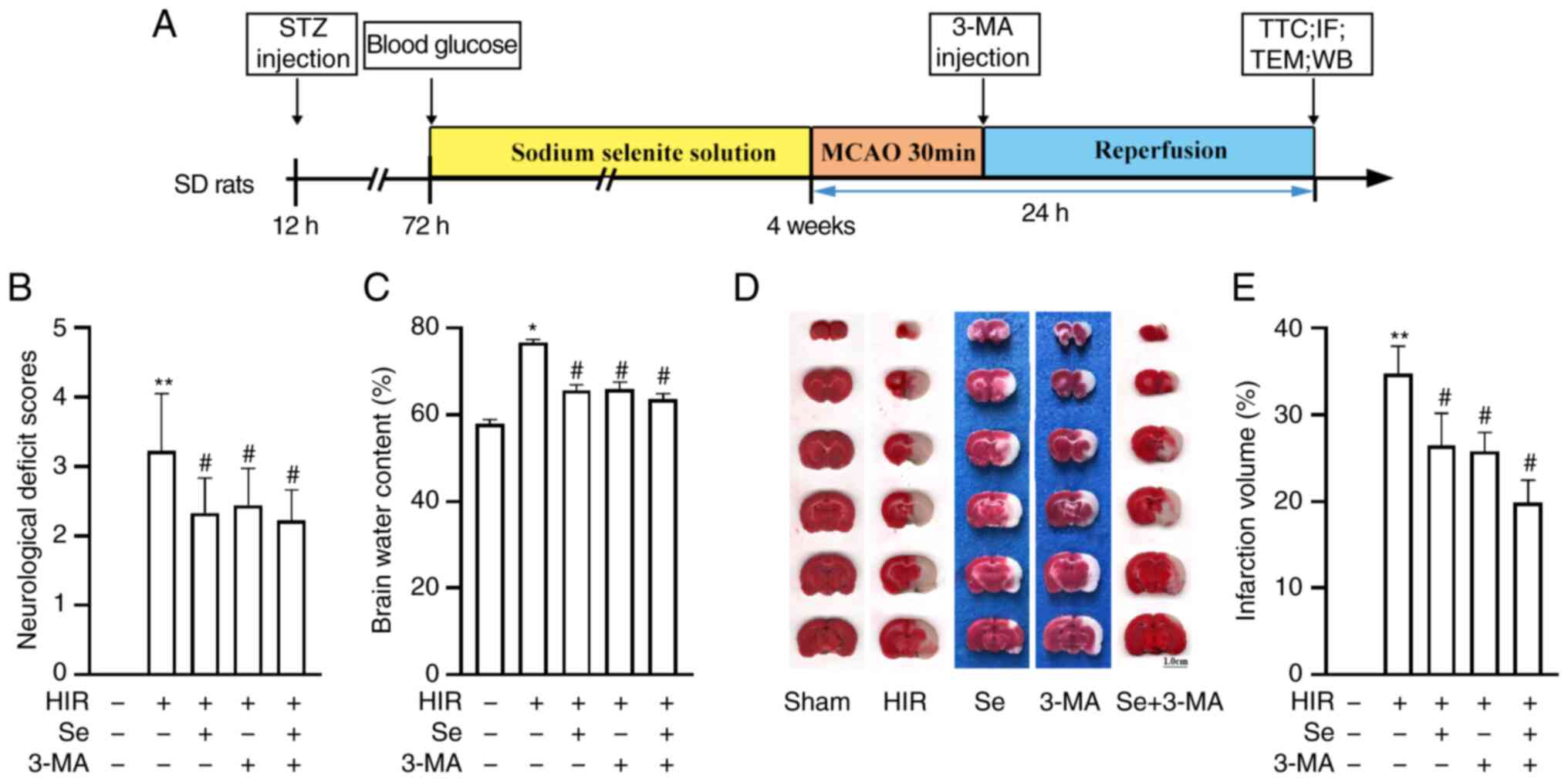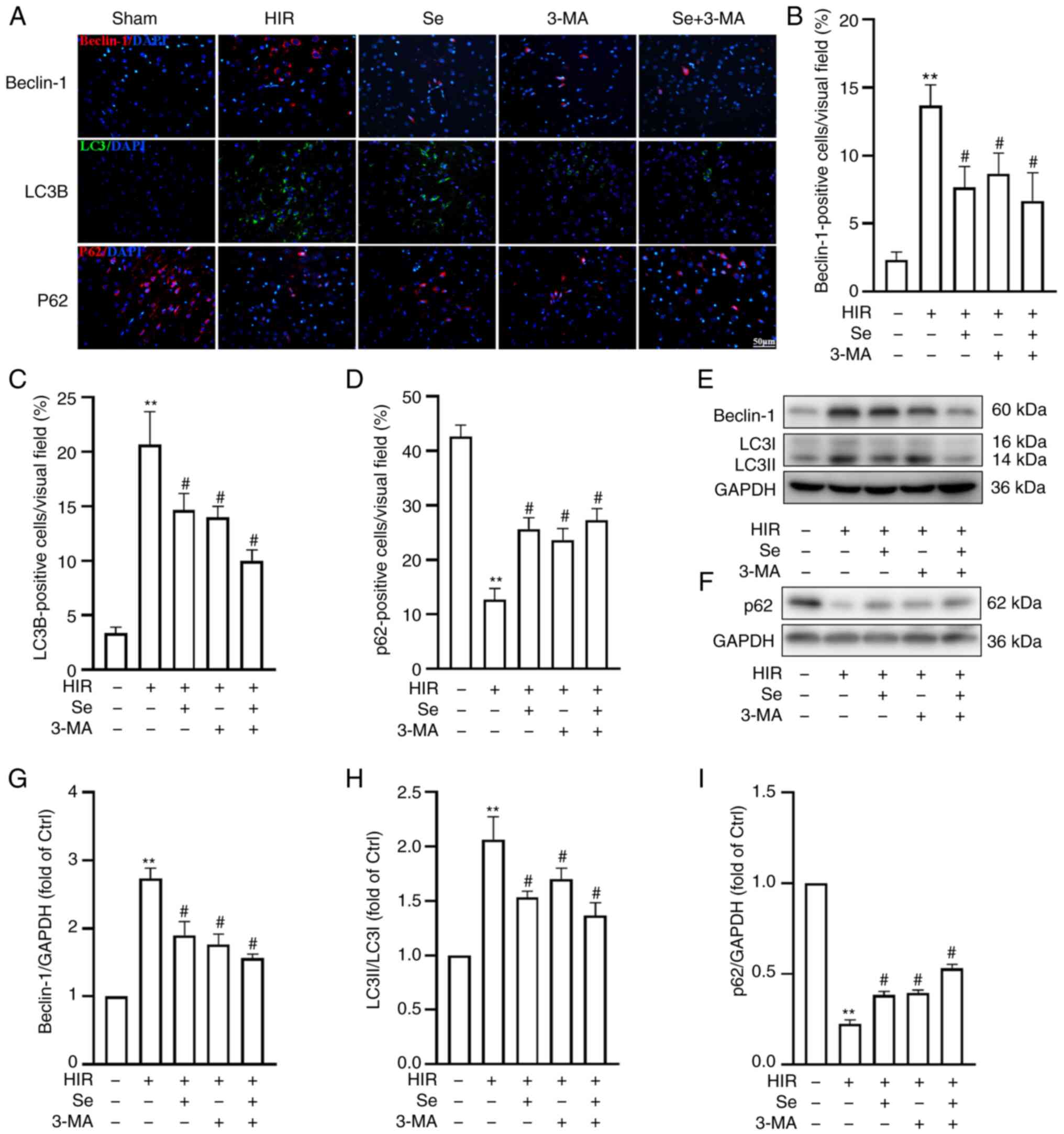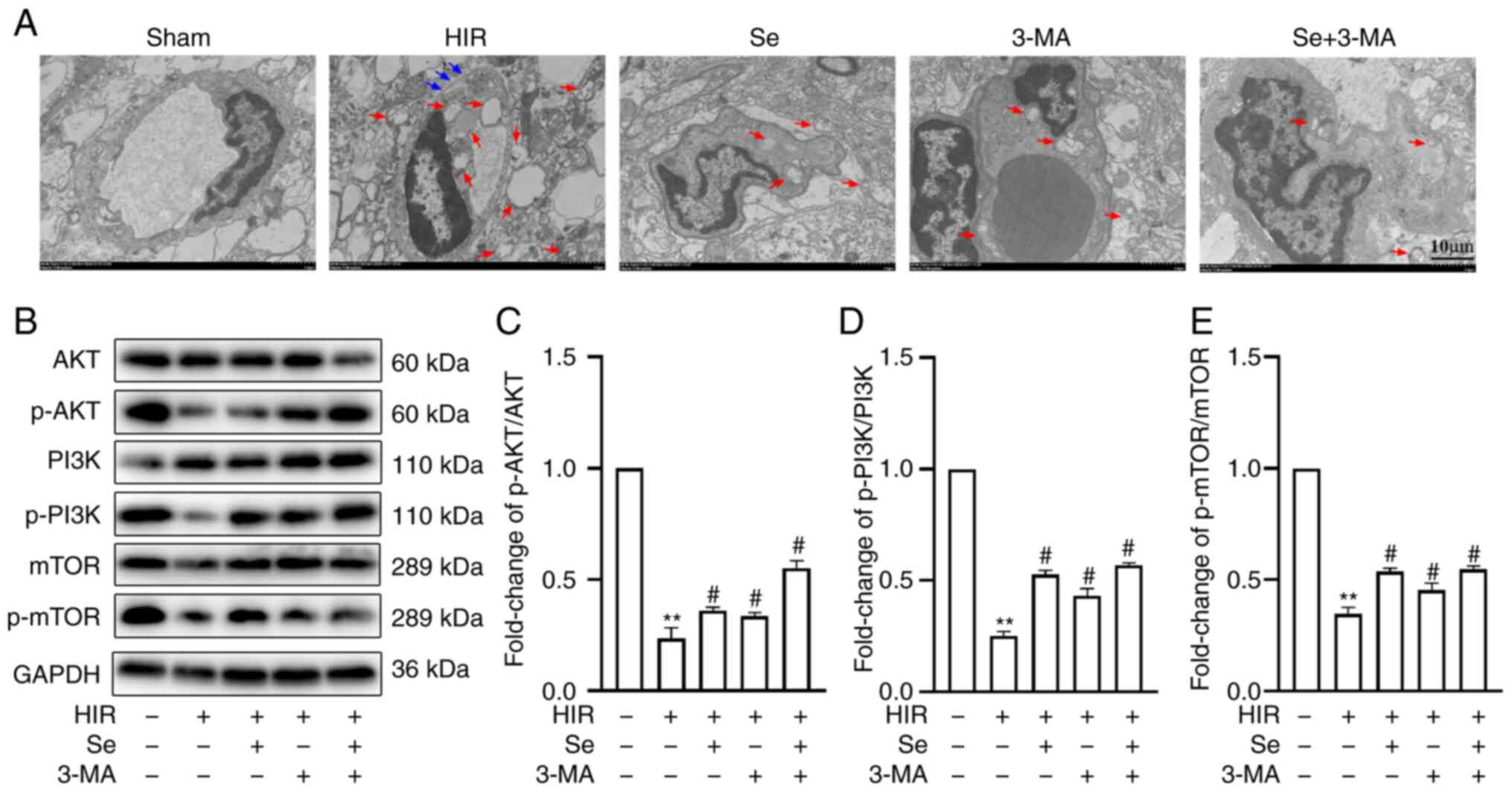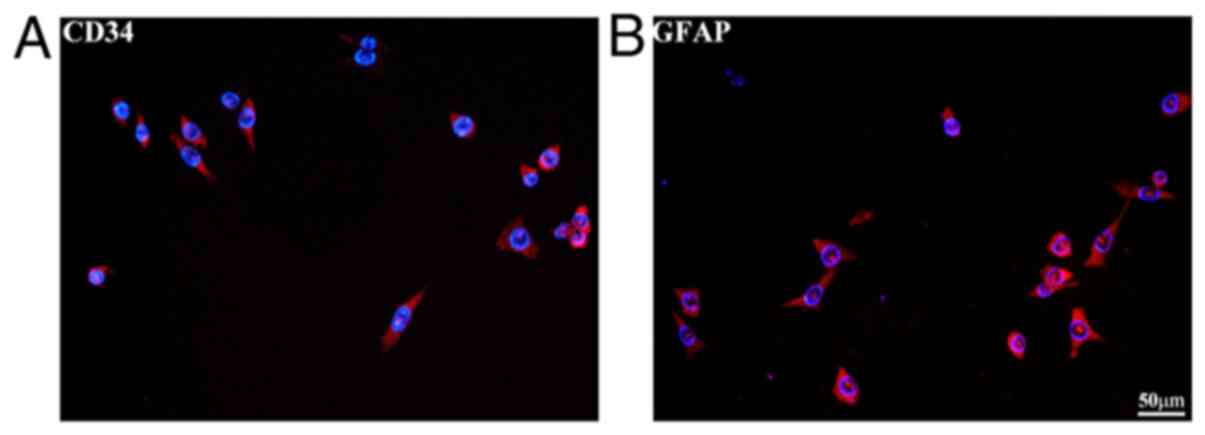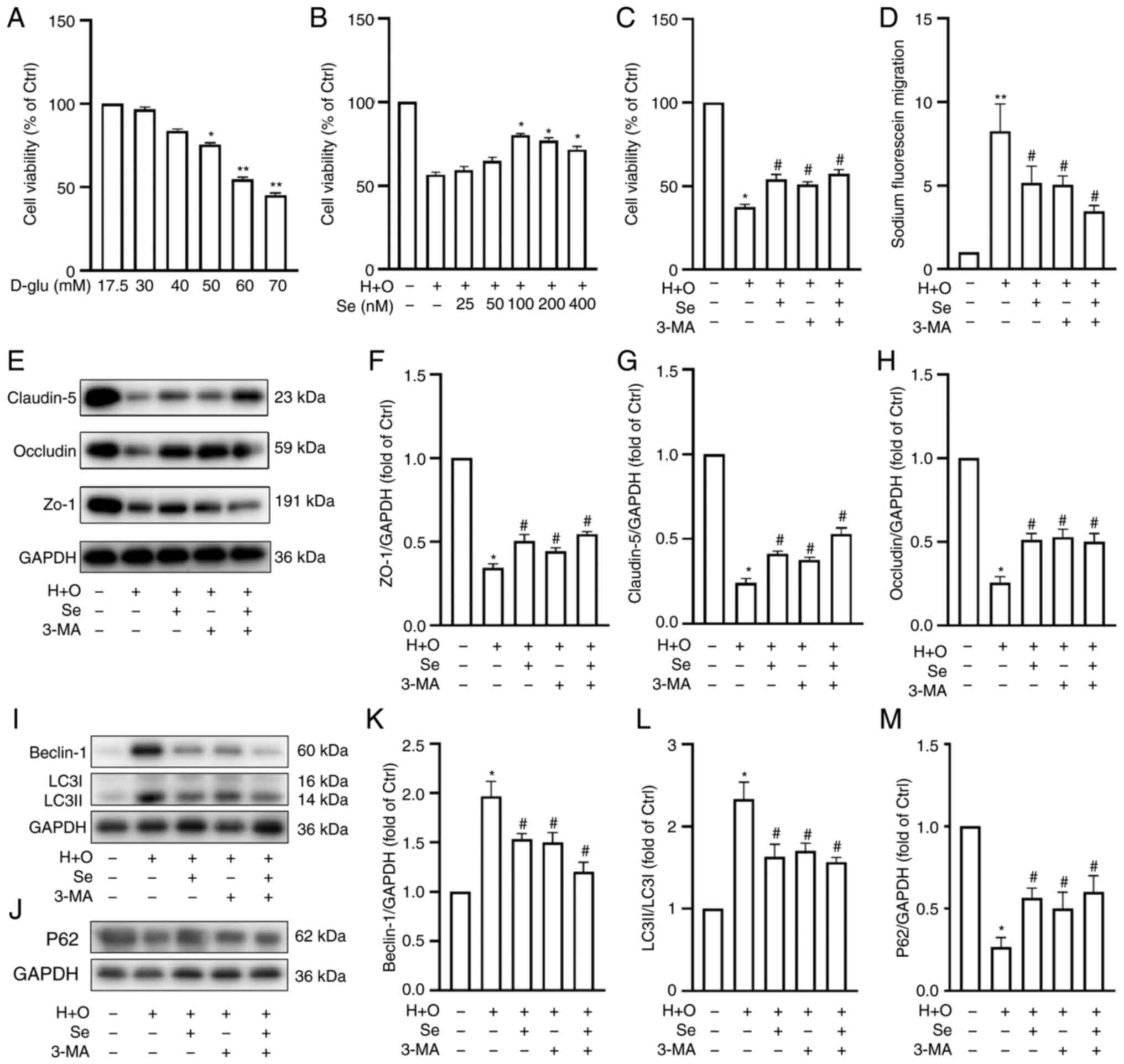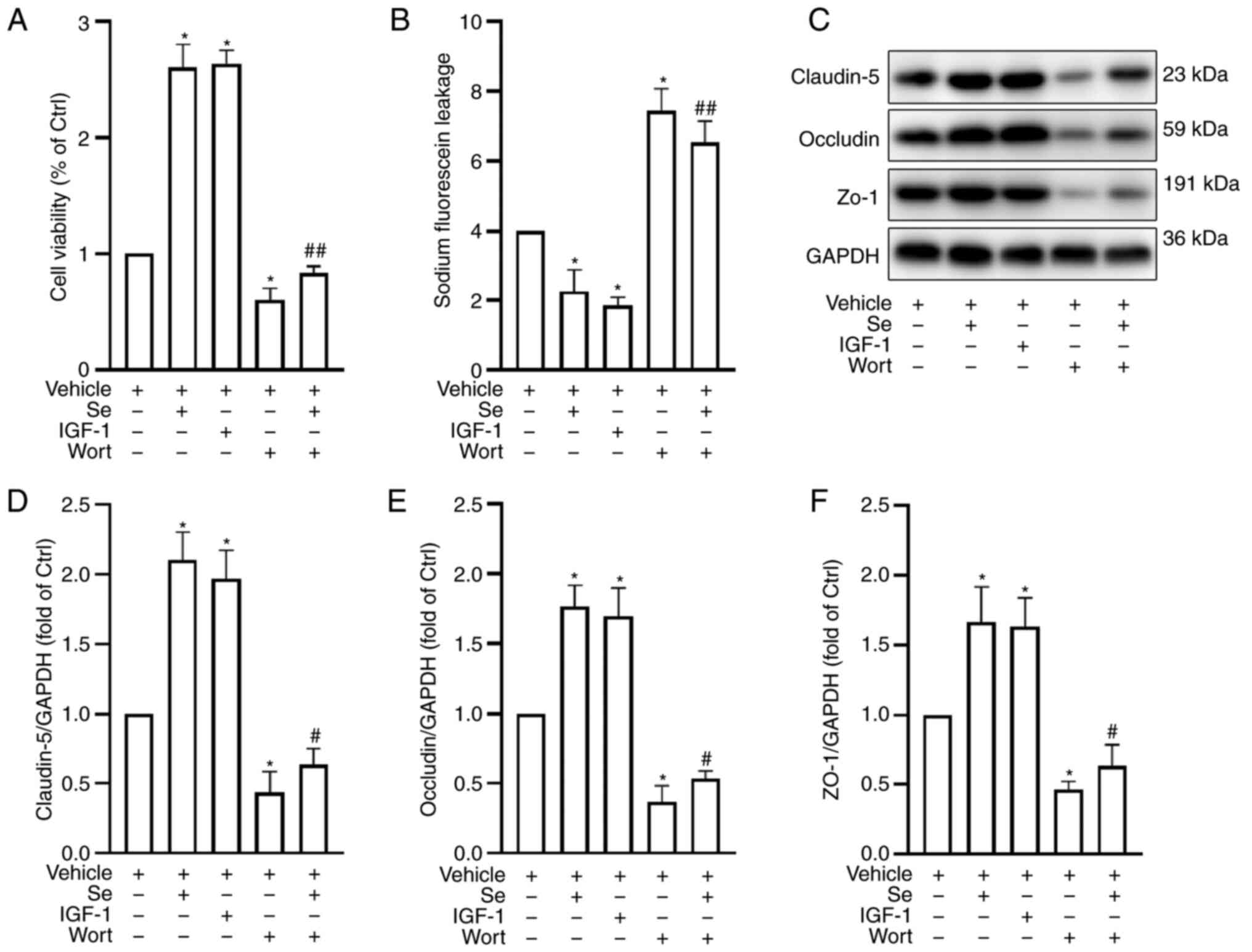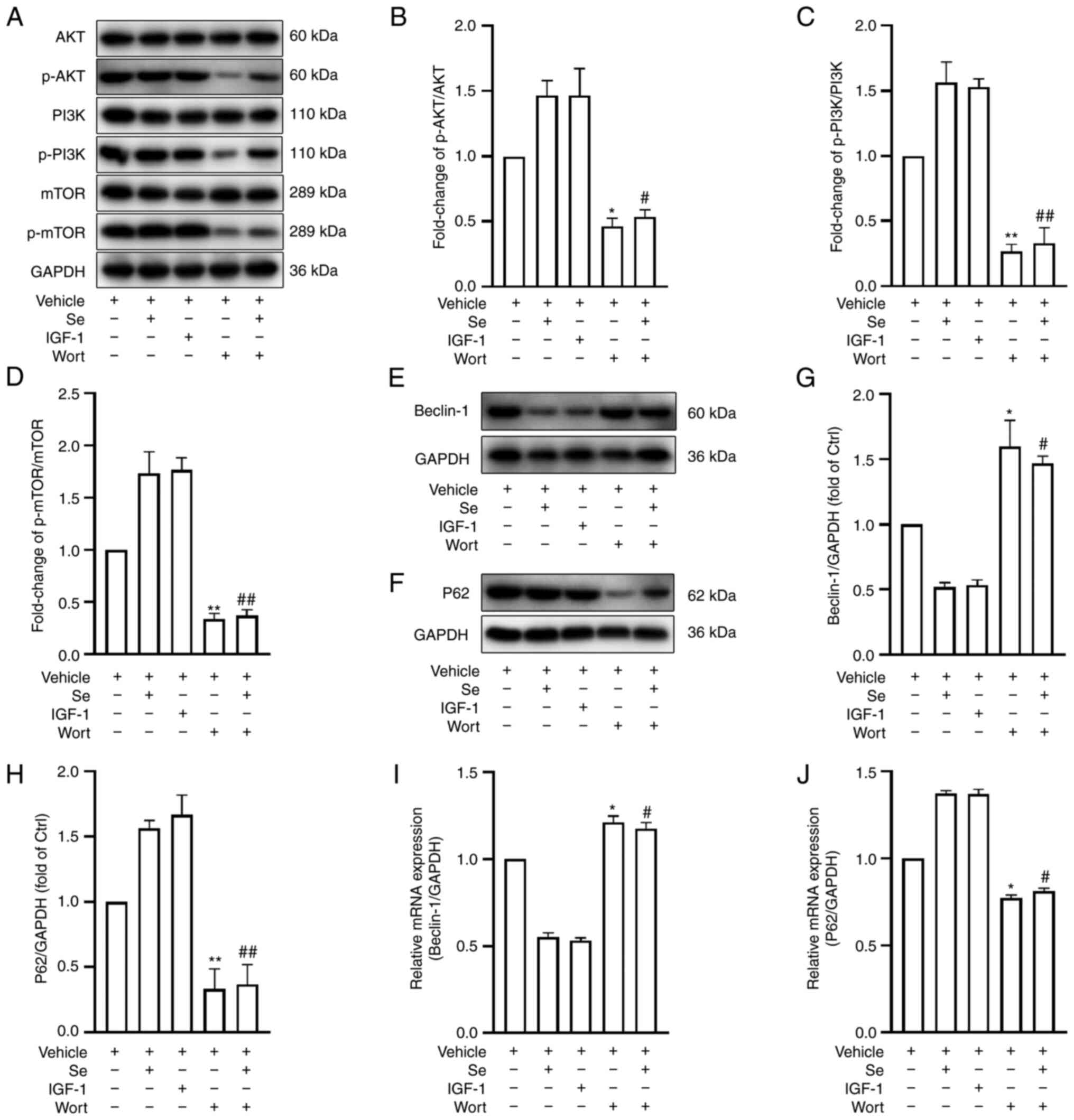|
1
|
Liu MB, Wang W, Gao JM, Li F, Shi JS and
Gong QH: Icariside II attenuates cerebral
ischemia/reperfusion-induced blood-brain barrier dysfunction in
rats via regulating the balance of MMP9/TIMP1. Acta Pharmacol Sin.
41:1547–1556. 2020. View Article : Google Scholar
|
|
2
|
Gao J, Long L, Xu F, Feng L, Liu Y, Shi J
and Gong Q: Icariside II, a phosphodiesterase 5 inhibitor,
attenuates cerebral ischaemia/reperfusion injury by inhibiting
glycogen synthase kinase-3β-mediated activation of autophagy. Br J
Pharmacol. 177:1434–1452. 2020. View Article : Google Scholar
|
|
3
|
Wu C, Chen J, Yang R, Duan F, Li S and
Chen X: Mitochondrial protective effect of neferine through the
modulation of nuclear factor erythroid 2-related factor 2
signalling in ischaemic stroke. Br J Pharmacol. 176:400–415. 2019.
View Article : Google Scholar
|
|
4
|
Venkat P, Chopp M and Chen J: Blood-brain
barrier disruption, vascular impairment, and ischemia/reperfusion
damage in diabetic stroke. J Am Heart Assoc. 6:e0058192017.
View Article : Google Scholar
|
|
5
|
Shou J, Zhou L, Zhu S and Zhang X:
Diabetes is an independent risk factor for stroke recurrence in
stroke patients: A meta-analysis. J Stroke Cerebrovasc Dis.
24:1961–1968. 2015. View Article : Google Scholar
|
|
6
|
Chen J, Cui X, Zacharek A, Cui Y, Roberts
C and Chopp M: White matter damage and the effect of matrix
metalloproteinases in type 2 diabetic mice after stroke. Stroke.
42:445–452. 2011. View Article : Google Scholar
|
|
7
|
Zhang X, Wei M, Fan J, Yan W, Zha X, Song
H, Wan R, Yin Y and Wang W: Ischemia-induced upregulation of
autophagy preludes dysfunctional lysosomal storage and associated
synaptic impairments in neurons. Autophagy. 17:1519–1542. 2021.
View Article : Google Scholar
|
|
8
|
Chen J, Ye X, Yan T, Zhang C, Yang XP, Cui
X, Cui Y, Zacharek A, Roberts C, Liu X, et al: Adverse effects of
bone marrow stromal cell treatment of stroke in diabetic rats.
Stroke. 42:3551–3558. 2011. View Article : Google Scholar
|
|
9
|
Wang W, Li M, Chen Q and Wang J:
Hemorrhagic transformation after tissue plasminogen activator
reperfusion therapy for ischemic stroke: Mechanisms, models, and
biomarkers. Mol Neurobiol. 52:1572–1579. 2015. View Article : Google Scholar
|
|
10
|
Karatas H, Eun Jung J, Lo EH and van Leyen
K: Inhibiting 12/15-lipoxygenase to treat acute stroke in permanent
and tPA induced thrombolysis models. Brain Res. 1678:123–128. 2018.
View Article : Google Scholar
|
|
11
|
Muir KW: Stroke in 2015: The year of
endovascular treatment. Lancet Neurol. 15:2–3. 2016. View Article : Google Scholar
|
|
12
|
Zhang Y, Cao Y and Liu C: Autophagy and
ischemic stroke. Adv Exp Med Biol. 1207:111–134. 2020. View Article : Google Scholar
|
|
13
|
Puyal J, Vaslin A, Mottier V and Clarke
PG: Postischemic treatment of neonatal cerebral ischemia should
target autophagy. Ann Neurol. 66:378–389. 2009. View Article : Google Scholar
|
|
14
|
Wei K, Wang P and Miao CY: A double-edged
sword with therapeutic potential: An updated role of autophagy in
ischemic cerebral injury. CNS Neurosci Ther. 18:879–886. 2012.
View Article : Google Scholar
|
|
15
|
Feng D, Wang B, Wang L, Abraham N, Tao K,
Huang L, Shi W, Dong Y and Qu Y: Pre-ischemia melatonin treatment
alleviated acute neuronal injury after ischemic stroke by
inhibiting endoplasmic reticulum stress-dependent autophagy via
PERK and IRE1 signalings. J Pineal Res. 62:2017. View Article : Google Scholar
|
|
16
|
Yang Z, Lin P, Chen B, Zhang X, Xiao W, Wu
S, Huang C, Feng D, Zhang W and Zhang J: Autophagy alleviates
hypoxia-induced blood-brain barrier injury via regulation of CLDN5
(claudin 5). Autophagy. 1–20. 2020.Online ahead of print.
|
|
17
|
Li H, He Y, Zhang C, Ba T, Guo Z, Zhuo Y,
He L and Dai H: NOX1 down-regulation attenuated the autophagy and
oxidative damage in pig intestinal epithelial cell following
transcriptome analysis of transport stress. Gene. 763:1450712020.
View Article : Google Scholar
|
|
18
|
Kim KA, Kim D, Kim JH, Shin YJ, Kim ES,
Akram M, Kim EH, Majid A, Baek SH and Bae ON: Autophagy-mediated
occludin degradation contributes to blood-brain barrier disruption
during ischemia in bEnd.3 brain endothelial cells and rat ischemic
stroke models. Fluids Barriers CNS. 17:212020. View Article : Google Scholar
|
|
19
|
Zhang Y, Zhang X, Wei Q, Leng S, Li C, Han
B, Bai Y, Zhang H and Yao H: Activation of sigma-1 receptor
enhanced pericyte survival via the interplay between apoptosis and
autophagy: Implications for blood-brain barrier integrity in
stroke. Transl Stroke Res. 11:267–287. 2020. View Article : Google Scholar
|
|
20
|
Wei N, Yu SP, Gu XH, Chen DD, Whalin MK,
Xu GL, Liu XF and Wei L: The involvement of autophagy pathway in
exaggerated ischemic brain damage in diabetic mice. CNS Neurosci
Ther. 19:753–763. 2013.
|
|
21
|
Che H, Li H, Li Y, Wang YQ, Yang ZY, Wang
RL and Wang LH: Melatonin exerts neuroprotective effects by
inhibiting neuronal pyroptosis and autophagy in STZ-induced
diabetic mice. FASEB J. 34:14042–14054. 2020. View Article : Google Scholar
|
|
22
|
Fu B, Zeng Q, Zhang Z, Qian M, Chen J,
Dong W and Li M: Epicatechin gallate protects HBMVECs from
ischemia/reperfusion injury through ameliorating apoptosis and
autophagy and promoting neovascularization. Oxid Med Cell Longev.
2019:78246842019. View Article : Google Scholar
|
|
23
|
Wei R, Liu H, Chen R, Sheng Y and Liu T:
Astragaloside IV combating liver cirrhosis through the
PI3K/Akt/mTOR signaling pathway. Exp Ther Med. 17:393–397.
2019.
|
|
24
|
Wu C, Yang M, Liu R, Hu H, Ji L, Zhang X,
Huang S and Wang L: Nicotine reduces human brain microvascular
endothelial cell response to Escherichia coli K1 infection by
inhibiting autophagy. Front Cell Infect Microbiol. 10:4842020.
View Article : Google Scholar
|
|
25
|
Wang M, Li YJ, Ding Y, Zhang HN, Sun T,
Zhang K, Yang L, Guo YY, Liu SB, Zhao MG and Wu YM: Silibinin
prevents autophagic cell death upon oxidative stress in cortical
neurons and cerebral ischemia-reperfusion injury. Mol Neurobiol.
53:932–943. 2016. View Article : Google Scholar
|
|
26
|
Liu YP, Shao SJ and Guo HD: Schwann cells
apoptosis is induced by high glucose in diabetic peripheral
neuropathy. Life Sci. 248:1174592020. View Article : Google Scholar
|
|
27
|
Liu Y, Chen X, Yao J and Kang J: Circular
RNA ACR relieves high glucose-aroused RSC96 cell apoptosis and
autophagy via declining microRNA-145-3p. J Cell Biochem. Dec
30–2019.Online ahead of print. View Article : Google Scholar
|
|
28
|
Arias-Borrego A, Callejón-Leblic B,
Calatayud M, Gómez-Ariza JL, Collado MC and Garcia-Barrera T:
Insights into cancer and neurodegenerative diseases through
selenoproteins and the connection with gut microbiota-current
analytical methodologies. Expert Rev Proteomics. 16:805–814. 2019.
View Article : Google Scholar
|
|
29
|
Yang J, Hamid S, Cai J, Liu Q, Xu S and
Zhang Z: Selenium deficiency-induced thioredoxin suppression and
thioredoxin knock down disbalanced insulin responsiveness in
chicken cardiomyocytes through PI3K/Akt pathway inhibition. Cell
Signal. 38:192–200. 2017. View Article : Google Scholar
|
|
30
|
Zhang Z, Liu M, Guan Z, Yang J, Liu Z and
Xu S: Disbalance of calcium regulation-related genes in broiler
hearts induced by selenium deficiency. Avian Pathol. 46:265–271.
2017. View Article : Google Scholar
|
|
31
|
Zhang Q, Zhang C, Ge J, Lv MW, Talukder M,
Guo K, Li YH and Li JL: Ameliorative effects of resveratrol against
cadmium-induced nephrotoxicity via modulating nuclear xenobiotic
receptor response and PINK1/Parkin-mediated mitophagy. Food Funct.
11:1856–1868. 2020. View Article : Google Scholar
|
|
32
|
Feng C, Li D, Chen M, Jiang L, Liu X, Li
Q, Geng C, Sun X, Yang G, Zhang L and Yao X: Citreoviridin induces
myocardial apoptosis through PPAR-γ-mTORC2-mediated autophagic
pathway and the protective effect of thiamine and selenium. Chem
Biol Interact. 311:1087952019. View Article : Google Scholar
|
|
33
|
Zhang C, Wang LL, Cao CY, Li N, Talukder M
and Li JL: Selenium mitigates cadmium-induced crosstalk between
autophagy and endoplasmic reticulum stress via regulating calcium
homeostasis in avian leghorn male hepatoma (LMH) cells. Environ
Pollut. 265:1146132020. View Article : Google Scholar
|
|
34
|
Lu C, Guo Y, Zhang Y, Yang L, Chang Y,
Zhang JW, Jing L and Zhang JZ: Coenzyme Q10 ameliorates cerebral
ischemia reperfusion injury in hyperglycemic rats. Pathol Res
Pract. 213:1191–1199. 2017. View Article : Google Scholar
|
|
35
|
MacArthur Clark JA and Sun D: Guidelines
for the ethical review of laboratory animal welfare People's
Republic of China national standard GB/T 35892-2018 (issued 6
February 2018 effective from 1 September 2018). Animal Model Exp
Med. 3:103–113. 2020. View Article : Google Scholar
|
|
36
|
Sun X, Wang D, Zhang T, Lu X, Duan F, Ju
L, Zhuang X and Jiang X: Eugenol Attenuates cerebral
ischemia-reperfusion injury by enhancing autophagy via
AMPK-mTOR-P70S6K pathway. Front Pharmacol. 11:842020. View Article : Google Scholar
|
|
37
|
Fan X, Qiu J, Yu Z, Dai H, Singhal AB, Lo
EH and Wang X: A rat model of studying tissue-type plasminogen
activator thrombolysis in ischemic stroke with diabetes. Stroke.
43:567–570. 2012. View Article : Google Scholar
|
|
38
|
Yang L, Ma YM, Shen XL, Fan YC, Zhang JZ,
Li PA and Jing L: The involvement of mitochondrial biogenesis in
selenium reduced hyperglycemia-aggravated cerebral ischemia injury.
Neurochem Res. 45:1888–1901. 2020. View Article : Google Scholar
|
|
39
|
Liu L, Cen J, Man Y, Li J, Zhang D, Wang
F, Li J, Ma J, Wang X and Ji B: Transplantation of human umbilical
cord blood mononuclear cells attenuated ischemic injury in MCAO
Rats via inhibition of NF-κB and NLRP3 inflammasome. Neuroscience.
369:314–324. 2018. View Article : Google Scholar
|
|
40
|
Yu Q, Li Q, Yang X, Liu Q, Deng J, Zhao Y,
Hu R and Dai M: Dexmedetomidine suppresses the development of
abdominal aortic aneurysm by downregulating the mircoRNA-21/PDCD 4
axis. Int J Mol Med. 47:902021. View Article : Google Scholar
|
|
41
|
Xiong D, Deng Y, Huang B, Yin C, Liu B,
Shi J and Gong Q: Icariin attenuates cerebral ischemia-reperfusion
injury through inhibition of inflammatory response mediated by
NF-κB, PPARα and PPARγ in rats. Int Immunopharmacol. 30:157–162.
2016. View Article : Google Scholar
|
|
42
|
Tureyen K, Bowen K, Liang J, Dempsey RJ
and Vemuganti R: Exacerbated brain damage, edema and inflammation
in type-2 diabetic mice subjected to focal ischemia. J Neurochem.
116:499–507. 2011. View Article : Google Scholar
|
|
43
|
Zhang G, Zhang T, Li N, Wu L, Gu J, Li C,
Zhao C, Liu W, Shan L, Yu P, et al: Tetramethylpyrazine nitrone
activates the BDNF/Akt/CREB pathway to promote post-ischaemic
neuroregeneration and recovery of neurological functions in rats.
Br J Pharmacol. 175:517–531. 2018. View Article : Google Scholar
|
|
44
|
Fang L, Li X, Zhong Y, Yu J, Yu L, Dai H
and Yan M: Autophagy protects human brain microvascular endothelial
cells against methylglyoxal-induced injuries, reproducible in a
cerebral ischemic model in diabetic rats. J Neurochem. 135:431–440.
2015. View Article : Google Scholar
|
|
45
|
Tian X, Peng J, Zhong J, Yang M, Pang J,
Lou J, Li M, An R, Zhang Q, Xu L and Dong Z: β-Caryophyllene
protects in vitro neurovascular unit against oxygen-glucose
deprivation and re-oxygenation-induced injury. J Neurochem.
139:757–768. 2016. View Article : Google Scholar
|
|
46
|
Mysiorek C, Culot M, Dehouck L, Derudas B,
Staels B, Bordet R, Cecchelli R, Fenart L and Berezowski V:
Peroxisome-proliferator-activated receptor-alpha activation
protects brain capillary endothelial cells from oxygen-glucose
deprivation-induced hyperpermeability in the blood-brain barrier.
Curr Neurovasc Res. 6:181–193. 2009. View Article : Google Scholar
|
|
47
|
Liu M, Pi H, Xi Y, Wang L, Tian L, Chen M,
Xie J, Deng P, Zhang T, Zhou C, et al: KIF5A-dependent axonal
transport deficiency disrupts autophagic flux in trimethyltin
chloride-induced neurotoxicity. Autophagy. 17:903–924. 2021.
View Article : Google Scholar
|
|
48
|
Rastogi M and Singh SK: Zika virus NS1
affects the junctional integrity of human brain microvascular
endothelial cells. Biochimie. 176:52–61. 2020. View Article : Google Scholar
|
|
49
|
Livak K and Schmittgen T: Analysis of
relative gene expression data using real-time quantitative PCR and
the 2(-Delta Delta C(T)) method. Methods. 25:402–408. 2001.
View Article : Google Scholar
|
|
50
|
Manthari RK, Tikka C, Ommati MM, Niu R,
Sun Z and Wang J, Zhang J and Wang J: Arsenic-induced autophagy in
the developing mouse cerebellum: Involvement of the blood-brain
Barrier's tight-junction proteins and the PI3K-Akt-mTOR signaling
pathway. J Agric Food Chem. 66:8602–8614. 2018. View Article : Google Scholar
|
|
51
|
Franke H, Galla H and Beuckmann C: Primary
cultures of brain microvessel endothelial cells: A valid and
flexible model to study drug transport through the blood-brain
barrier in vitro. Brain Res Brain Res Protoc. 5:248–256. 2000.
View Article : Google Scholar
|
|
52
|
Hamprecht B and Löffler F: Primary glial
cultures as a model for studying hormone action. Comparative Study.
109:341–345. 1985.
|
|
53
|
Lee KJ, Lee JS and Jung KH: Interactive
effect of acute and chronic glycemic indexes for severity in acute
ischemic stroke patients. BMC Neurol. 18:1052018. View Article : Google Scholar
|
|
54
|
Ji Q, Han J, Wang L, Liu J, Dong Y, Zhu K
and Shi L: MicroRNA-34a promotes apoptosis of retinal vascular
endothelial cells by targeting SIRT1 in rats with diabetic
retinopathy. Cell Cycle. 19:2886–2896. 2020. View Article : Google Scholar
|
|
55
|
Tu Y, Guo C, Song F, Huo Y, Geng Y, Guo M,
Bao H, Wu X and Fan W: Mild hypothermia alleviates diabetes
aggravated cerebral ischemic injury via activating autophagy and
inhibiting pyroptosis. Brain Res Bull. 150:1–12. 2019. View Article : Google Scholar
|
|
56
|
Kumari R, Bettermann K, Willing L, Sinha K
and Simpson IA: The role of neutrophils in mediating stroke injury
in the diabetic db/db mouse brain following hypoxia-ischemia.
Neurochem Int. 139:1047902020. View Article : Google Scholar
|
|
57
|
Okada T, Suzuki H, Travis ZD and Zhang JH:
The stroke-induced blood-brain barrier disruption: Current progress
of inspection technique, mechanism, and therapeutic target. Curr
Neuropharmacol. 18:1187–1212. 2020. View Article : Google Scholar
|
|
58
|
Li W, Qu Z, Prakash R, Chung C, Ma H, Hoda
MN, Fagan SC and Ergul A: Comparative analysis of the neurovascular
injury and functional outcomes in experimental stroke models in
diabetic Goto-Kakizaki rats. Brain Res. 1541:106–114. 2013.
View Article : Google Scholar
|
|
59
|
Venkat P, Zacharek A, Landschoot-Ward J,
Wang F, Culmone L, Chen Z, Chopp M and Chen J: Exosomes derived
from bone marrow mesenchymal stem cells harvested from type two
diabetes rats promotes neurorestorative effects after stroke in
type two diabetes rats. Exp Neurol. 334:1134562020. View Article : Google Scholar
|
|
60
|
Nian K, Harding IC, Herman IM and Ebong
EE: Blood-brain barrier damage in ischemic stroke and its
regulation by endothelial mechanotransduction. Front Physiol.
11:6053982020. View Article : Google Scholar
|
|
61
|
Tietz S and Engelhardt B: Brain barriers:
Crosstalk between complex tight junctions and adherens junctions. J
Cell Biol. 209:493–506. 2015. View Article : Google Scholar
|
|
62
|
Cui X, Chopp M, Zacharek A, Ye X, Roberts
C and Chen J: Angiopoietin/Tie2 pathway mediates type 2 diabetes
induced vascular damage after cerebral stroke. Neurobiol Dis.
43:285–292. 2011. View Article : Google Scholar
|
|
63
|
Shao Z, Dou S, Zhu J, Wang H, Xu D, Wang
C, Cheng B and Bai B: The role of mitophagy in ischemic stroke.
Front Neurol. 11:6086102020. View Article : Google Scholar
|
|
64
|
Xu W, Ocak U, Gao L, Tu S, Lenahan CJ,
Zhang J and Shao A: Selective autophagy as a therapeutic target for
neurological diseases. Cell Mol Life Sci. 78:1369–1392. 2021.
View Article : Google Scholar
|
|
65
|
Chen L, Zhang B and Toborek M: Autophagy
is involved in nanoalumina-induced cerebrovascular toxicity.
Nanomedicine. 9:212–221. 2013. View Article : Google Scholar
|
|
66
|
Xiao Y, Fan M, Jin W, Li WA, Jia Y, Dong
Y, Jiang X, Xu J, Meng N and Lv P: Lithium chloride ameliorated
spatial cognitive impairment through activating mTOR
phosphorylation and inhibiting excessive autophagy in the repeated
cerebral ischemia-reperfusion mouse model. Exp Ther Med.
20:1092020. View Article : Google Scholar
|
|
67
|
Menzie-Suderam JM, Modi J, Xu H, Bent A,
Trujillo P, Medley K, Jimenez E, Shen J, Marshall M, Tao R, et al:
Granulocyte-colony stimulating factor gene therapy as a novel
therapeutics for stroke in a mouse model. J Biomed Sci. 27:992020.
View Article : Google Scholar
|
|
68
|
Fu C, Zhang X, Lu Y, Wang F, Xu Z, Liu S,
Zheng H and Liu X: Geniposide inhibits NLRP3 inflammasome
activation via autophagy in BV-2 microglial cells exposed to
oxygen-glucose deprivation/reoxygenation. Int Immunopharmacol.
84:1065472020. View Article : Google Scholar
|
|
69
|
Zhao B, Yuan Q, Hou JB, Xia ZY, Zhan LY,
Li M, Jiang M, Gao WW and Liu L: Inhibition of HDAC3 ameliorates
cerebral ischemia reperfusion injury in diabetic mice in vivo and
in vitro. J Diabetes Res. 2019:85208562019. View Article : Google Scholar
|
|
70
|
Pan Q, Liu Y, Wang G, Wen Z and Wang Y:
MTMR14 protects against cerebral stroke through suppressing
PTEN-regulated autophagy. Biochem Biophys Res Commun.
529:1045–1052. 2020. View Article : Google Scholar
|
|
71
|
Nazarinia D, Aboutaleb N, Gholamzadeh R,
Nasseri Maleki S, Mokhtari B and Nikougoftar M: Conditioned medium
obtained from human amniotic mesenchymal stem cells attenuates
focal cerebral ischemia/reperfusion injury in rats by targeting
mTOR pathway. J Chem Neuroanat. 102:1017072019. View Article : Google Scholar
|
|
72
|
Wu F, Xu K, Xu K, Teng C, Zhang M, Xia L,
Zhang K, Liu L, Chen Z, Xiao J, et al: Dl-3n-butylphthalide
improves traumatic brain injury recovery via inhibiting
autophagy-induced blood-brain barrier disruption and cell
apoptosis. J Cell Mol Med. 24:1220–1232. 2020. View Article : Google Scholar
|
|
73
|
Heras-Sandoval D, Pérez-Rojas JM,
Hernández-Damián J and Pedraza-Chaverri J: The role of
PI3K/AKT/mTOR pathway in the modulation of autophagy and the
clearance of protein aggregates in neurodegeneration. Cell Signal.
26:2694–2701. 2014. View Article : Google Scholar
|
|
74
|
Wang M, Liang X, Cheng M, Yang L, Liu H,
Wang X, Sai N and Zhang X: Homocysteine enhances neural stem cell
autophagy in in vivo and in vitro model of ischemic stroke. Cell
Death Dis. 10:5612019. View Article : Google Scholar
|















